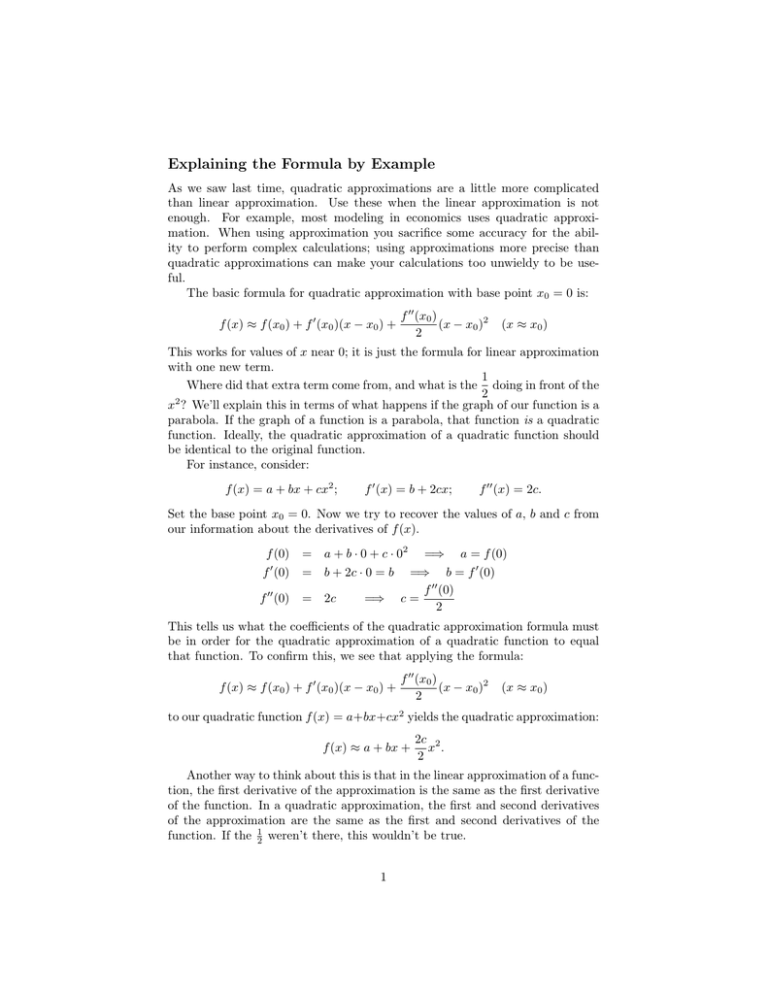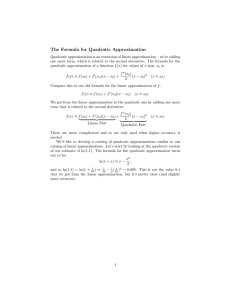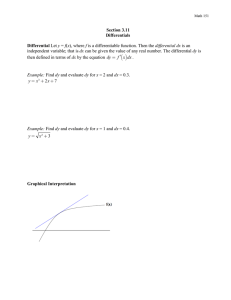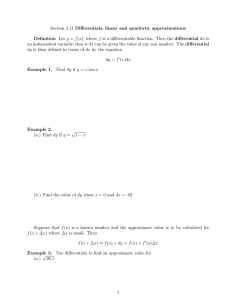Explaining the Formula by Example
advertisement

Explaining the Formula by Example As we saw last time, quadratic approximations are a little more complicated than linear approximation. Use these when the linear approximation is not enough. For example, most modeling in economics uses quadratic approxi­ mation. When using approximation you sacrifice some accuracy for the abil­ ity to perform complex calculations; using approximations more precise than quadratic approximations can make your calculations too unwieldy to be use­ ful. The basic formula for quadratic approximation with base point x0 = 0 is: f (x) ≈ f (x0 ) + f � (x0 )(x − x0 ) + f �� (x0 ) (x − x0 )2 2 (x ≈ x0 ) This works for values of x near 0; it is just the formula for linear approximation with one new term. 1 Where did that extra term come from, and what is the doing in front of the 2 x2 ? We’ll explain this in terms of what happens if the graph of our function is a parabola. If the graph of a function is a parabola, that function is a quadratic function. Ideally, the quadratic approximation of a quadratic function should be identical to the original function. For instance, consider: f (x) = a + bx + cx2 ; f � (x) = b + 2cx; f �� (x) = 2c. Set the base point x0 = 0. Now we try to recover the values of a, b and c from our information about the derivatives of f (x). = a + b · 0 + c · 02 f (0) = b + 2c · 0 = b f �� (0) = 2c f (0) � =⇒ =⇒ a = f (0) =⇒ b = f � (0) f �� (0) c= 2 This tells us what the coefficients of the quadratic approximation formula must be in order for the quadratic approximation of a quadratic function to equal that function. To confirm this, we see that applying the formula: f (x) ≈ f (x0 ) + f � (x0 )(x − x0 ) + f �� (x0 ) (x − x0 )2 2 (x ≈ x0 ) to our quadratic function f (x) = a+bx+cx2 yields the quadratic approximation: f (x) ≈ a + bx + 2c 2 x . 2 Another way to think about this is that in the linear approximation of a func­ tion, the first derivative of the approximation is the same as the first derivative of the function. In a quadratic approximation, the first and second derivatives of the approximation are the same as the first and second derivatives of the function. If the 12 weren’t there, this wouldn’t be true. 1 MIT OpenCourseWare http://ocw.mit.edu 18.01SC Single Variable Calculus�� Fall 2010 �� For information about citing these materials or our Terms of Use, visit: http://ocw.mit.edu/terms.



